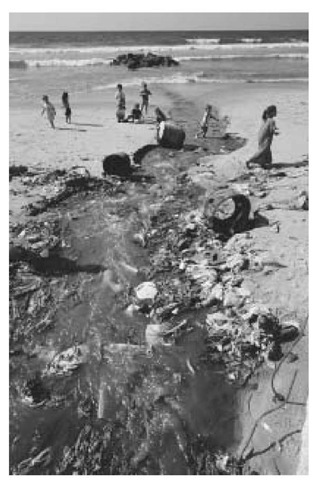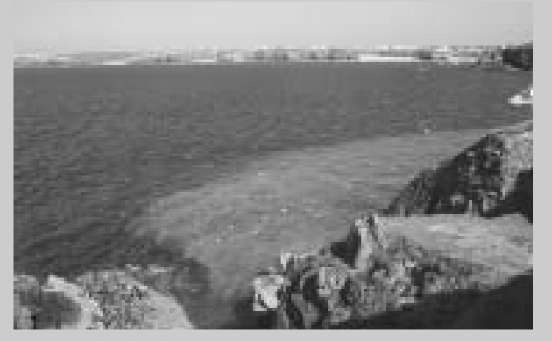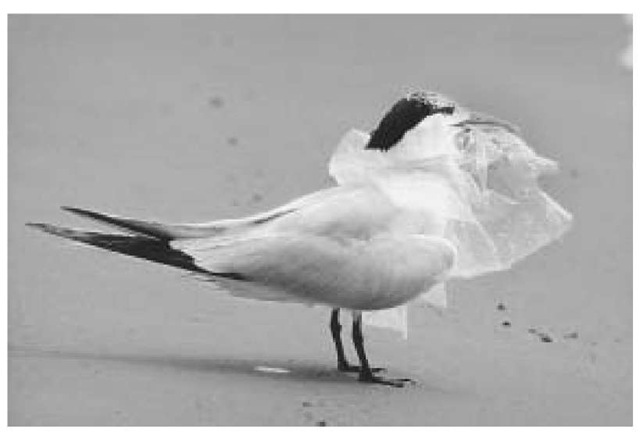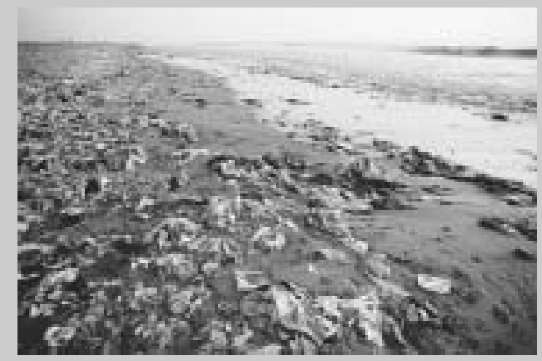Pollution is defined as the addition of harmful substances into the ecosystem (the network of interactions between living organisms and their environment). Pollutants might be slightly harmful to humans, but very harmful to aquatic life. For instance, in certain lakes and rivers when acid rain (rain polluted with acidic chemicals) falls upon them, toxic (poisonous) metals that cause fish to die are released from sediments (particles of soil, sand, and minerals, and animal or plant matter washed from land into water). These metals—chromium, aluminum, and mercury are just a few—are harmful to fish. But humans would have to ingest much larger quantities than the aquatic or marine life. The toxins also accumulate in the tissues of fish as they eat other fish (ingest) or plants containing toxins. If one were to catch and eat a fish that has a high content of toxins in them the human is affected too. Metals are not the only pollutants that are of concern, as evidenced by oil spills that kill marine life in large quantities and persist on beaches and in sediments for a long time. Industrial processes produce harmful waste, and often this is discharged into a nearby stream, river, or ocean. There are many ways to cause pollution and many types of pollutants.
Levels of pollution
Transportation is a leading source of pollution, both in the atmosphere (mass of air surrounding Earth) and in water reserves. Every time oil or gasoline is spilled on the roadway, it eventually is transported to the nearest water reserve. Many of these reserves are groundwater. Groundwater is freshwater that resides in rock and soil layers beneath Earth’s land surface, and groundwater can eventually transport pollutants into rivers, streams, and the sea. Thus, pollutants can come from large areas or specific areas. These are referred to as non-point source and point-source pollution, respectively.
If the source of pollution is able to be identified and "pointed" to, the source of pollution is point-source. Point sources include drainage pipes from factories, leaky underground gasoline tanks, and places where people discard used motor oil. Non-point sources are far more reaching, such as the transportation example. Not only do toxic chemicals come from leaky automobiles and gasoline spills, they come from exhaust fumes that are taken into the atmosphere and then are brought back down to earth in rain. A smokestack that releases hazardous gasses into the air might very well be responsible for acid rain many miles away, but it would be hard to identify the source if the factory was a sufficient distance from the site of the rainfall event.
Young children play near a stream of sewage on a beach in Gaza.
How do pollutants affect the world around us? An oil spill renders seabirds flightless, because the oil coats their feathers. Oil makes areas of waterfront land uninhabitable, and some animals (turtles) bury eggs in the sand and thus they are affected too. Metal contamination from industrial processes—like the ones mentioned above as well as lead, arsenic, antimony, and cadmium—are by-products of the manufacturing of many types of goods. It turns out that chemicals contained in oil and gasoline are carcinogenic, which means they can cause cancer. The metals, known as heavy metals, can cause damage to many organs in one’s body, most notably the liver and the brain.
Even "land based" pollutants eventually make their way into groundwater, streams, and rivers. Many older houses were painted with paint that contained lead, and that anyone who eats paint chips from these older homes can develop mental difficulties because lead is very toxic. Mercury is used in thermostats in many homes, in thermometers, and in industry. It is also used in batteries, but to a limited extent. Mercury can combine with other elements to form one of the most dangerous chemicals known to man, dimethyl mercury. A single drop can kill a person in less than one month. Arsenic is used, among other things, to make lumber resist rotting. However, the arsenic gets soaked from the wood eventually and ends up in the ecosystem.
Sewage
In this photo from 1994, sewage is emptied into the ocean near Cornwall, England, where the tide carries it toward beaches.
Untreated sewage from humans and animals poses a problem to water sources. Because of limited facilities in developing countries to handle the processing of this waste, many times it is simply dumped into rivers or oceans untreated. These substances contain disease-causing organisms and present a danger to the health of humans and animals.
Sewage disposal is not only a problem in developing countries; in May 2004, the city of Milwaukee, Wisconsin, dumped 1.5 billion gallons (5.6 million liters) of untreated sewage into Lake Michigan, enough sewage to fill 5,000 Olympic-sized swimming pools. The problem stems from Milwaukee’s storm drainage system, which is interconnected with the sewer system. After a heavy rain, the storm drainage pipes and sewer pipes both fill with runoff and the sewers cannot handle the extra load. The result is an overflow and Milwaukee water officials were forced to dump the sewage rather than allow it to back up directly into people’s bathrooms and basements. Milwaukee officials are studying different plans in order to choose the best method of separating the city’s storm and sewer systems.
Sources and types of pollutants
The population of Earth is over six billion people, and not all countries adhere to the same regulations about protecting the environment. Before the industrial revolution in the late nineteenth century, pollution of sea water and surface waters was largely attributable to natural causes, such as drought (prolonged below-normal levels of rain) conditions that in turn, led to increased concentrations of various compounds in the water supply. When automobiles and gasoline-powered machinery became available, pollution surged, due to increased output of consumer goods and machinery. Conservation laws in many developed countries have helped to correct pollution in many air and water sources since the time of the industrial revolution. Some developing countries still use highly-polluting products such as fuel with lead components, and environmental scientists are now concentrating their efforts in studying the long-term effects of water and air pollution on a worldwide scope.
Plastic material dumped in the water chokes the neck of a Royal shroud bird.
Not all pollution is attributed to oil spills, industry, and transportation. Humans contribute to pollution in the course of everyday activities. Washing automobiles, lawn fertilizers, cleaning products eventually end up in the water supply. The soap and shampoo from bathing, disinfectants for cleaning the kitchen and bathroom, nail polish, and the waxes and oils for cleaning floors are just a few examples of home products that contribute to the pollution of the water supply. Lawnmowers are very inefficient when it comes to cleaning exhaust, so the gasses end up in the atmosphere and fall to Earth in rain. Medical products, such as antibiotics contain substances that are helpful to some organisms but not to others, and the introduction of these substances can result in the killing of aquatic life or altering the reproductive cycles of various species.
Based on many years of scientific studies, there are regulations from the U.S. government as to acceptable levels of particular pollutants. For instance, the human body needs chromium, but very little of it, and a person gets it automatically from eating a balanced diet. Iron is critical for making sure oxygen gets transported with blood cells but too much iron is dangerous. The Environmental Protection Agency (EPA) is a U.S. government division that monitors the levels of contaminants (pollutants) in the ecosystem. Based on studies with animals, plants, and humans, the EPA has determined what levels of many pollutants can be ingested with no proven risk of health trouble. Adhering to these standards is expensive because industries that produce pollutants must buy expensive equipment to filter the harmful chemicals (as well as gasses) from the waters they discharge. The price is passed along to the consumer by raising product prices. This was the case in the early 1980s with gasoline, when adding a lead-based compound to gasoline prolonged engine life. The risks of the added lead outweighed the benefits, and the government decided to ban lead-products in gasoline and replace them with a chemical that essentially does the same job, but is non-toxic.
Ocean Dumping
Cholera infested garbage and chemical waste covers a beach in Lima, Peru.
A major concern of the damage of the quality of ocean waters is the dumping of garbage. It is a common practice to load barges with millions of pounds of refuse every day and sail offshore for several miles, then dump the contents into the sea. Many items in these garbage barges are toxic, such as metals from old batteries and medical waste. Other items, such as decaying foodstuffs, are dangerous sources of bacteria that are harmful for all life. Although dumping garbage far out to sea is supposed to result in natural degradation (breaking apart), various currents, storms, and other physical events often lead to garbage washing back to shore, where it again enters the pollution cycle.
WORDS TO KNOW
Acid rain: The result of acidic chemicals reacting in the atmosphere with water and returning to earth as contaminated rain, fog, or snow.
Ecosystem: The network of interactions between living organisms and their environment.
Groundwater: Freshwater that resides in rock and soil layers beneath Earth’s land surface.




